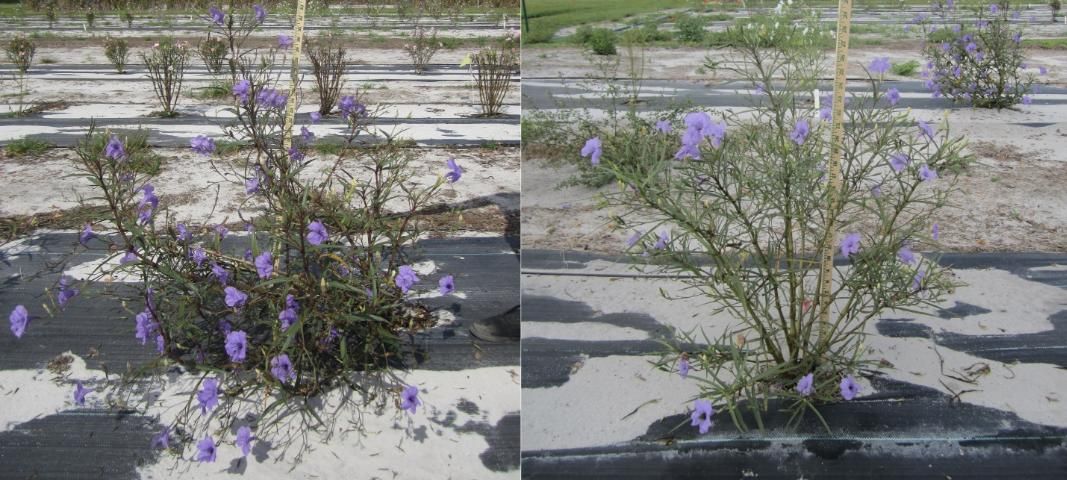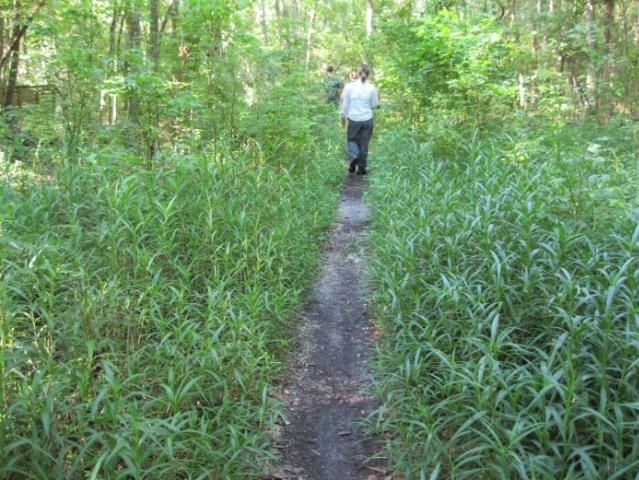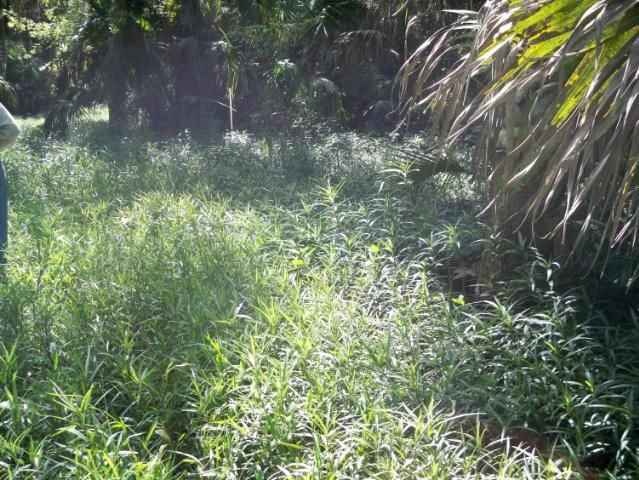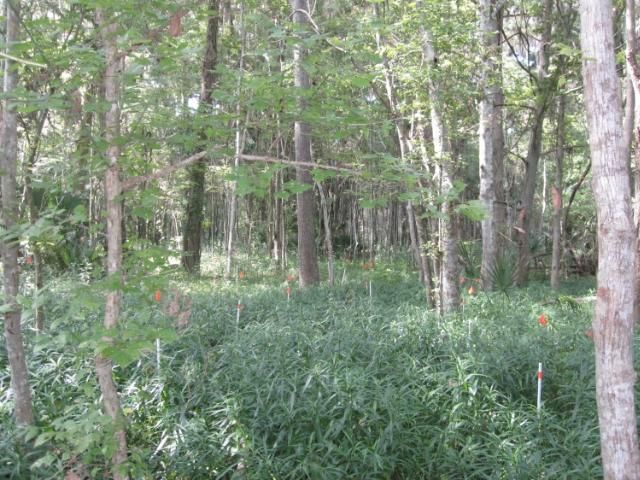What is Mexican petunia?
Mexican petunia (Ruellia simplex C. Wright) is an ornamental plant species popular in southeastern landscapes and gardens. It is native to Mexico, the Antilles, western Bolivia, southwestern Brazil, Paraguay, Uruguay and northwest Argentina (Ezcurran and Daniel 2007), and it is also found throughout the southeastern United States (Wunderlin and Hansen 2013). Its tolerance of varying urban landscape conditions makes it a common choice for difficult to plant areas. Mexican petunia tolerates shade, sun, wet, dry, and poor soil conditions. It is a prolific bloomer with flowers in shades of purple and pink peaking in the summer, but with the potential to also bloom in spring and fall in some parts of Florida (Tobe et al. 1998).
When Mexican petunia originally became available in the ornamental plant trade in the United States, only wild-type plants were available. Plant breeders have since produced a number of cultivars that produce flowers in different shades of purple, pink, and white (Hupp et al. 2009). Dwarf cultivars have also been produced (Hupp et al. 2009). The 'Purple Showers' cultivar was the first sterile (does not set seed) cultivar produced for the nursery trade, and is still the predominant cultivar available from retail garden centers and wholesale nurseries. Three new cultivars for the landscape have been developed recently at the University of Florida and are now being sold as cultivars 'Mayan Purple, 'Mayan White' and 'Mayan Pink' (Freyre at al. 2012; Freyre, personal communication). The simplest method for urban landscape managers to distinguish between the wild-type and sterile cultivars in the landscape is to observe plants to see if they set seed. The sterile cultivar 'Purple Showers' has larger flowers and is taller than the wild-type plants, but at certain times of the year or if 'Purple Shower' plants have been cut back, they are not easily distinguishable from the wild-type plants. The new sterile cultivars are also visually distinct from the wild-type. They can be distinguished by flower color and a more compact growth habit.

Credit: Rosanna Freyre
Why can Mexican petunia be a problem?
Environmental tolerance, abundant seed production, and an ability to easily grow from plant stem sections (Reinhardt Adams, personal communication) have allowed Mexican petunia to spread into natural areas bordering urban areas. The Florida Exotic Pest Plant Council lists Mexican petunia (wild-type and non-sterile cultivars) as a Category 1 invasive species, meaning that it is "altering native plant communities by displacing native species, changing community structures or ecological functions, or hybridizing with natives" (Florida Exotic Pest Plant Council 2011). These potential changes to community structure and ecological function are of particular concern in Florida wetlands where changes to plant communities have the potential to impact not just plant-animal interactions, but also overall hydrology on a whole watershed level.
While there is a native species of Ruellia, it should not be confused with Mexican petunia. The native Carolina wild petunia (R. caroliniensis) is also found throughout the southeastern United States (USDA-NRCS 2013), but is a smaller plant and more sprawling than the Mexican petunia (Wilson et al. 2004). The Carolina wild petunia is generally found as individual plants rather than in dense stands like the Mexican petunia (Wilson et al. 2004). Additionally, the Carolina wild petunia grows as a short-lived annual wildflower, while the Mexican petunia has a perennial growth habit (Wilson et al. 2004).
Since its introduction, wild-type Mexican petunia has spread throughout the southeastern United States. The USDA has reported wild-type Mexican petunia as established in Texas, Louisiana, Georgia, Alabama, Mississippi, Florida, and South Carolina (USDA-NRCS 2013). Wunderlin and Hansen (2013) indicate that Mexican petunia has been vouchered in natural areas in 29 of 67 counties in Florida. The conclusion of the most recent Institute of Food and Agricultural Sciences (UF/IFAS) Assessment of the Status of Non-Native Plants in Florida's Natural Areas listed R. simplex as "invasive, not recommended" for all climatic zones in Florida (UF/IFAS Invasive Plant Working Group 2013). Researchers have observed dense stands of near monocultures of wild-type Mexican petunia in Florida floodplain forests, usually occurring in strips along the edges of streams and other wet areas (Hupp 2007; Randall Stocker, pers. com, personal observations).

Credit: Adrienne Smith

Credit: Adrienne Smith

Credit: Christine Wiese
Why is control of wild-type and non-sterile cultivars of Mexican petunia in urban landscapes and home gardens crucial to overall control of this invader?
Managing the invasion of non-native aggressive plant species is a key component of maintaining the health and functionality of plant ecosystems. Controlling invasive ornamental species often requires multiple methods to first establish and then maintain the health of the native vegetation (Tallent-Hasell and Watt 2009; Gooden et al. 2009; Hanula et al. 2009). A key part of maintaining control of a potential invading species is reducing or eliminating the source of propagules (seeds or other plant material that could generate more plants). Urban landscapes bordering nearby natural areas are a constant source of propagules for ornamental invasive species as long as these species remain in the urban landscape. Home gardeners have the opportunity to positively impact the quality of their neighboring natural areas by removing invasive ornamental species from their landscapes. Research on the control and behavior of Mexican petunia suggests that it can be best managed with a two-pronged approach: 1) control populations in invaded natural areas with glyphosate and native revegetation and 2) reduce the urban sources of Mexican petunia propagules, particularly the wild-type and non-sterile cultivars. While sterile cultivars like 'Purple Showers' have not yet been documented in natural areas, they can spread aggressively through vegetative means. It is up to those managing urban landscapes to responsibly care for plantings of sterile Mexican petunia. The UF/IFAS Assessment of the Status of Non-Native Plants in Florida's Natural Areas Infraspecific Taxon Protocol, a component of the UF/IFAS Assessment of Non-Native Plants in Florida's Natural Areas, reports that there is currently no documented evidence of invasion of the cultivars 'Purple Showers', 'Mayan Purple', 'Mayan White' or 'Mayan Pink' in natural areas (UF/IFAS Invasive Plant Working Group 2013).
Past agreements between nursery owners and others involved in the horticultural industry have been negotiated to reduce sales of known invasive species as well as reduce introductions of potentially invasive species (Baskin 2002; Foxcroft et al. 2008; Reichard 2004). Additionally, there is increasing pressure on ornamental plant growers to restrict sales of ornamental invasive species (Coats et al. 2011; Wirth et al. 2004). However, many ornamental species are already a frequent planting in urban landscapes and have already established themselves in natural areas. The invasion of ornamental invasive species is most likely to be a serious problem where urban landscapes are adjacent to natural areas and therefore provide consistent, nearby propagule sources of the invader (Foxcroft et al. 2008). In the case of Mexican petunia, reducing the urban propagule source is likely to be a key part of long-term reduction of the species in natural areas.
Many homeowners are unaware of which species that appear in the landscape are invasive (Gagliardo and Brand 2007; Reichard and White 2001). Reichard and White reported that less than half of home gardeners surveyed said they were aware of ornamental invasive species. To add to home gardeners' confusion, sterile cultivars of some invasive ornamental species have been developed that are safe for use in the home landscape (Tallent-Hasell and Watt 2009; Trueblood et al. 2010; Czarnecki and Deng 2009). However, while research has been done to develop sterile cultivars of Mexican petunia (Freyre et al. 2012), other research suggests that the primary method of propagule dispersion for Mexican petunia is vegetative rather than by seed (Reinhardt-Adams, personal communication). Therefore, the introduction of sterile cultivars of Mexican petunia as the only management action will likely not sufficiently reduce the propagule source for this species. We suggest removal of all wild-type and non-sterile cultivars of this species from the urban landscape will be an important part of managing this invading species in adjacent natural areas.

Credit: Keona Nolan
What is being done to control escaped Mexican petunia in natural areas?
Researchers conducted a preliminary evaluation of herbicides and evaluated the need for a follow-up spray for control of Mexican petunia in natural areas (Hupp et al. 2009). They found that all tested ready-mixed herbicides successfully controlled Mexican petunia invasions (Hupp et al. 2009). Adams et al. (2013, submitted) also examined herbicide control of Mexican petunia in natural areas. Specifically, they evaluated seasonal effectiveness of herbicide applications as well as the need for repeat applications to achieve sufficient control of the invader. They also evaluated effect of season of glyphosate applications and number of repeat applications on post-treatment vegetation quality. They found that, with sufficient spray coverage, glyphosate could control Mexican petunia with one or two applications regardless of which season the glyphosate was applied (Adams et al. 2013, submitted.). Adams et al. (2013, submitted) and Hupp et al. (2009) both found that a follow-up application resulted in the best control, particularly where complete spray coverage was difficult to obtain.
While season of glyphosate application did not influence control of Mexican petunia, it did impact total and native species richness; both were greater when glyphosate treatments were initiated in fall as compared to spring. Overall quality of the vegetation after glyphosate treatment (as measured by the FAQWet index; Ervin et al. 2006) was greater when glyphosate treatments were initiated in the fall and a second application was applied at three months after the initial treatment compared to applying glyphosate only once (Adams et al. 2013, submitted). Although Stocker et al. (see Wiese et al. 2013, submitted) did not quantify native species composition of post-herbicide treatment vegetation; they observed that newly emerged vegetation did not appear to constitute a diverse native plant community. Hupp (2007) examined potential competition between Mexican petunia and native vegetation by evaluating Mexican petunia seed germination and survival in uncleared plots and in plots cleared of existing native vegetation; she found survival of Mexican petunia seedlings was higher in cleared plots where there was no competition with existing native vegetation (Hupp 2007). This suggests that maintaining existing native vegetation and actively introducing additional native vegetation will be important factors in preventing reinvasion after Mexican petunia control is achieved.
What can you do to responsibly manage Mexican petunia in your landscape?
-
Do not buy or plant wild type or non-sterile cultivars of Mexican petunia. Be cautious about accepting Mexican petunia plants from friends or neighbors unless you are sure they are a sterile cultivar. If this is a plant that you especially enjoy, keep checking in with nurseries to see if they are carrying sterile varieties yet. The sterile variety 'Purple Showers' is commonly available in the garden trade and three new sterile varieties, 'Mayan Purple', 'Mayan White' and 'Mayan Pink' are now being sold (Freyre at al. 2012; Freyre, personal communication).
-
If you are growing sterile cultivars of Mexican petunia, manage the plant in your landscape responsibly. Do not dispose of plant clippings where they could root and spread uncontrolled. Home owners and others managing urban landscapes should proactively prevent the vegetative portions of Mexican petunia from being disposed of in storm water drains or waterways, where they have the potential to be deposited in natural areas and become a future problem.
-
Remove established wild-type or non-sterile cultivars of Mexican petunia plants in your home landscape. Small areas or individual plants can be dug up by hand. Be sure to get the whole plant! Mexican petunia has underground rhizomes that will produce new plants if not removed. Large areas of Mexican petunia can be killed with herbicide. Many ready-mixed herbicides have been successfully used to control Mexican petunia. One of the most commonly used and easily available from local stores is glyphosate, which is sold under the trade name Roundup. Other ready-mixed herbicides that can be effectively used on Mexican petunia can be found here: https://edis.ifas.ufl.edu/ep415. Be sure to follow all label directions and wear all required personal protective equipment when applying herbicide. You may need to apply a follow-up herbicide application after 3-6 months depending on what degree of herbicide application coverage was achieved during the first spray. Dense invasions or those underneath fallen limbs or other debris often may require a second herbicide application to fully control the Mexican petunia. Caution: it is illegal to apply herbicide to Mexican petunia in natural areas outside your home landscape without permission from the landowner!
-
Plant something new in the bare ground left after the Mexican petunia is removed or dead. Holding the space with appropriate landscape plant material will minimize the chances of a reinvasion of Mexican petunia or a new invasion of other unwanted weeds. Choose sterile cultivars of Ruellia, another non-invasive ornamental species, or appropriate native species for your new plantings (Knox et al. 2013a; Knox et al. 2013b). Recommended plant material for Florida zones can be found here: https://edis.ifas.ufl.edu/ep467 and https://edis.ifas.ufl.edu/ep468.
References
Adams, C., C. Wiese, and L.C. Cobb. 2013. Effect of Season and Number of Glyphosate Applications on Control of Invasive Ruellia simplex. Journal of Invasive Plant Science and Management. Submitted.
Baskin, Y. 2002. The greening of horticulture: New codes of conduct aim to curb plant invasions. BioScience. 52:464-471.
Coats, V.C., L.B. Stack, and M.E. Rumpho. 2011. Maine nursery and landscape industry perspectives on invasive plant issues. Invasive Plant Science and Management. 4:378-389.
Czarnecki, D.M. II and Z. Deng. 2009. Occurrence of unreduced female gametes leads to sexual polyploidization in lantana. Journal of the American Society for Horticultural Science. 134:560-566.
Ervin, G.N., B.D. Herman, J.T. Bried, and D.C. Holly. 2006. Evaluating non-native species and wetland indicator status as components of wetlands floristic assessment. Wetlands 26:1114-1129.
Ezcurra, C. and T.F. Daniel. 2007. Ruellia simplex, an older and overlooked name for Ruellia tweediana and Ruellia coerulea (Acanthaceae). Darwiniana 45:201-203.
Florida Exotic Pest Plant Council. 2011. List of Invasive Plant Species. Florida Exotic Pest Plant Council. http://www.fleppc.org/list/09list.htm. Accessed Feb. 23, 2012.
Foxcroft, L.C., D.M. Richardson, J.R.U. Wilson. 2008. Ornamental plants as invasive aliens: Problems and solutions in Kruger National Park, South Africa. Environmental Management. 41:32-51.
Freyre, R., A. Moseley, G.W. Knox, and S.B. Wilson. 2012. Fruitless Ruellia simplex R10-102 ('Mayan Purple') and R10-108 ('Mayan White'). HortScience. 47:1808-1814.
Gagliardi, J.A. and M.H. Brand. 2007. Connecticut nursery and landscape industry preferences for solutions to the sale and use of invasive plants. HortTechnology. 17:39-45.
Gooden, B., K. French. P.J. Turner. 2009. Invasion and management of a woody plant, Lantana camara L., alters vegetation diversity within wet sclerophyll forest in southeastern Australia. Forest Ecology and Management. 257:960-967.
[GRIN] Germplasm Resources Information Network. 2004. National Germplasm Resources Laboratory, Beltsville, Maryland. http://www.ars-grin.gov/npgs/index.html. Accessed: November 2007
Hanula, J.L., S. Horn, and J.W. Taylor. 2009. Chinese privet (Ligustrum sinense) removal and its effect on native plant communities of riparian forests. Invasive Plant Science and Management. 2:292-300.
Hupp, K.V.S., A. M. Fox, S.B. Wilson, E. L. Barnett, and R. K. Stocker. 2009. Natural area weeds: Mexican petunia (Ruellia tweediana). UF/IFAS Extension ENH1155. 8p.
Hupp, K.V.S. 2007. Investigating the determinants of local scale distribution of Ruellia tweediana (synonym R. brittoniana) in natural areas. M.S. Thesis. Gainesville, FL: University of Florida. 108 p.
Knox, G.W., S.B. Wilson, Z. Deng, and R. Freyre. 2013a. Alternatives to invasive plants commonly found in north Florida landscapes. UF/IFAS Extension ENH1206. 3p.
Knox, G.W., S.B. Wilson, Z. Deng, and R. Freyre. 2013b. Alternatives to invasive plants commonly found in central Florida landscapes. IFAS Cooperative Extension ENH1207. 3p.
Reichard, S.H. 2004. Conflicting values and common goals: Codes of conduct to reduce the threat of invasive species. Weed Technology. 18:1503-1507.
Reichard, S.H. and P. White. 2001. Horticulture as a pathway of invasive plant introductions in the United States. BioScience. 51:103-113.
Tallent-Hasell, N.G. and M.S. Watt. 2009. The invasive Buddleja davidii. Botanical Review. 75:292-325.
Tobe, J. D., K. C. Burks, R. W. Cantrell, M. A. Garland, M. E. Sweeley, D. W. Hall, P. Wallace, G. Anglin, G. Nelson, J. R. Cooper, D. Bickner, K. Gillbert, N. Aymond, and K. Greenwood, N. Raymond. 1998. Florida wetland plants: An identification manual. Tallahassee, FL: Florida Department of Environmental Protection. 59 pp.
Trueblood, C.E., T.G. Ranney, N.P. Lynch, J.C. Neal, and R.T. Olsen. 2010. Evaluating fertility of triploid clones of Hypericum androsaemum L. for use as non-invasive landscape plants. HortScience. 45:1026-1028.
University of Florida, Institute of Food and Agricultural Sciences. 2018. "Assessment of Non-native Plants in Florida's Natural Areas" (https://assessment.ifas.ufl.edu, 4/29/2019) Gainesville, FL, 32611-4000, USA.
Wiese, C., C. Reinhardt-Adams, and A. M. Smith. 2013. Experimental research informs control of Mexican petunia (Ruellia simplex) in natural areas and home-gardens. Proc. Fl. State Hort. Soc. 20:x-x. in press.
Wilson, S.B., P.C. Wilson, and J.A. Albano. 2004. Growth and development of the native Ruellia caroliniensis and invasive Ruellia tweediana. HortScience. 39:1015-1019.
Wirth, F.F., K.J. Davis, and S.B. Wilson. 2004. Florida nursery sales and economic impacts of 14 potentially invasive landscape plant species. Journal of Environmental Horticulture. 22:12-16.
Wunderlin, R.P. and B.F. Hansen 2013. Atlas of Florida Vascular Plants. http://www.plantatlas.usf.edu Accessed June 17, 2013.
USDA-NRCS U.S. Department of Agriculture Forest Service, Natural Resources Conservation Service. 2013. The PLANTS Database. http://plants.usda.gov. Accessed June. 17, 2013.